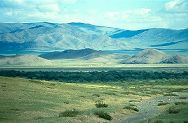The steppes of Mongolia
Mongolia is a very big country. It has been assumed that it has the richest unexplored natural resources in the world. It is also very sparsely populated: twenty-five percent of its only 3 million inhabitants (2016) live in the capital Ulaanbaatar. The remaining population is scattered over a limited number of villages and towns. Most of them, however, are nomadic herdsmen who seasonally wander with their families and livestock from one pastoral area to the other.
 Mongolia still has extended areas with undisturbed steppes. There one can find the highly valuable grassy mountain steppes and the arid steppes.
Mongolia still has extended areas with undisturbed steppes. There one can find the highly valuable grassy mountain steppes and the arid steppes.
Unfortunately even in this country these pristine steppes are being threatened. The major source of the national income is livestock breeding. The millions of grazing animals are a heavy burden on the carrying capacity of the steppe.
Successively wild grazers such as wild sheep, wild goats, gazelles and the wild horses had to make way for their domestic congenitors. The wild horse even became completely extinct from the wild in the late 1960s.
The Przewalski horse, the last wild forebear of the domestic horse: a threatened species
The last Przewalski horses in the wild were seen in 1968. That was in the area in which this species, that once spread over the entire Eurasian continent, had found its last refuge, the Tachyn Schar Nuruu in the Southwest on the border with China. It is certain that the species has become extinct from the wild.
Around 1900 a small number of Przewalski horses was caught from the wild; fifty-three of them did found their way to public and private zoos and wildlife parks all over the world. Today there are some 2,000 of them living in captivity. All of them descending from only thirteen wild caught forebears. During thirteen to fifteen generations, no fresh blood from the wild could be introduced in the captive population. Protracted captivity causes in wild animals a serious violation of their innate social behaviour patterns; the effects of the so-called “creeping domestication” are undeniable.
Reintroduction of animal species from captivity into the wild needs specific professional management. To realise the first phase of reintroduction, the Foundation Reserves Przewalski Horse (FRPH) founded six semi-reserves in the Netherlands and in Germany. In these semireserves, measuring from 30 to 260 ha., groups of Przewalski horses were able to live according to their inborn instincts in social groups. This founder population produced healthy and viable offspring, with capacity to live sustainably in Mongolia. Their descendants in Hustai National Park have a low inbreeding coefficient and all of them together are genetically very diverse.
Reintroduction, habitat selection and feasibility studies
In 1988 the joint Russian and Mongolian Biological expeditions inspected fifteen areas in Central Asia and Mongolia on their suitability for reintroduction of the Przewalski horses into the wild. It soon became clear that the pristine grasslands of Central Asia belonged to the most threatened ecosystems of the region.
Finally an area some 120 kilometres from the Mongolian capital Ulaanbaatar was chosen as the most suitable for the reintroduction and establishment of a free roaming Przewalski population. The selection was agreed by the Government and the local communities. This area, Hustain Nuruu, already had a long history as a protected region: first as the exclusive shooting ground of the last Khan and thereafter as pastoral reserve for the local people.
Przewalski horses return to Mongolia
 In 1990 the Mongolian Association for Conservation of Nature and Environment (MACNE), the FRPH, the governor of the Central Aimak (province) that ruled the Hustai area, and a few other organisations signed an agreement to cooperate. On March 2nd 1991 the Parliament of Mongolia ratified the project. The Mongolian people were also very eager to welcome back their “takhi” as is the name for “wild horse” in Mongolian. When on June 5th 1992 the first flight of sixteen horses landed at the airport of Ulaanbaatar hundreds of people came to welcome them.
In 1990 the Mongolian Association for Conservation of Nature and Environment (MACNE), the FRPH, the governor of the Central Aimak (province) that ruled the Hustai area, and a few other organisations signed an agreement to cooperate. On March 2nd 1991 the Parliament of Mongolia ratified the project. The Mongolian people were also very eager to welcome back their “takhi” as is the name for “wild horse” in Mongolian. When on June 5th 1992 the first flight of sixteen horses landed at the airport of Ulaanbaatar hundreds of people came to welcome them.
FRPH and MACNE are both responsible for the execution of two projects:
1. The Reintroduction Project for the Przewalski horses, which lasted ten consecutive years (1990 -2000);
2. The Hustain Nuruu Steppe Project (or biodiversity project), that was initiated in 1993 and which had a duration of ten years.
Building up a free roaming Przewalski population not only benefits this threatened species, but is also a enormous stimulus for the recovery of the original biodiversity of the steppe.
In November 1993 the Mongolian parliament granted Hustai the status of reserve. In 1997 it was upgraded to National Park. Little by little a legislation concerning the protection of the indigenous plant and animal wildlife was constructed. In spring of 1994 parliament accorded this law. In December 2002 the UNESCO enlisted Hustai National Park as Man and Biosphere Reserve.
Gradually the nomads and their livestock had to leave the 50,000 ha. large National Park. This happened in close cooperation with the local community. Hunting and poaching are forbidden. At present the area is totally free from livestock. Only in extreme bad weather conditions, the nomads are allowed to pasture and water their livestock temporarily, in specific sections of the Park.
